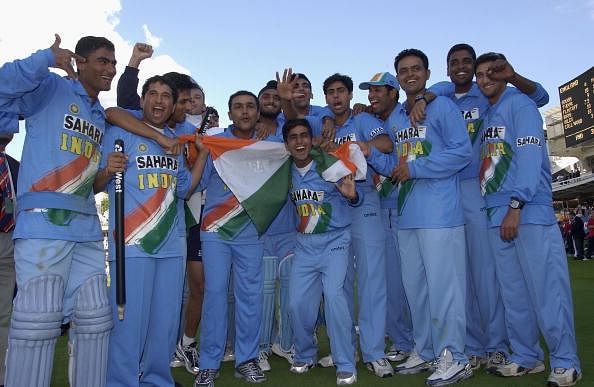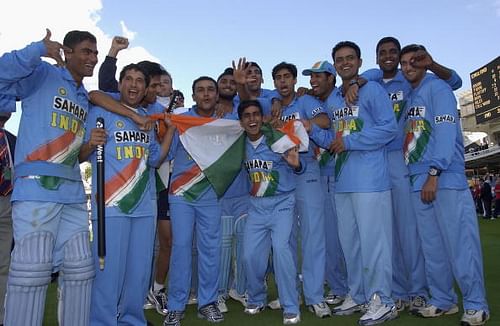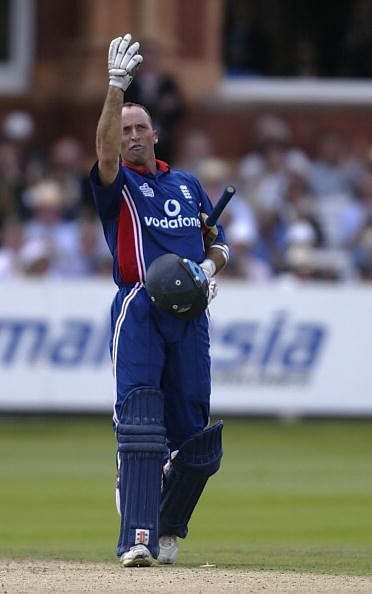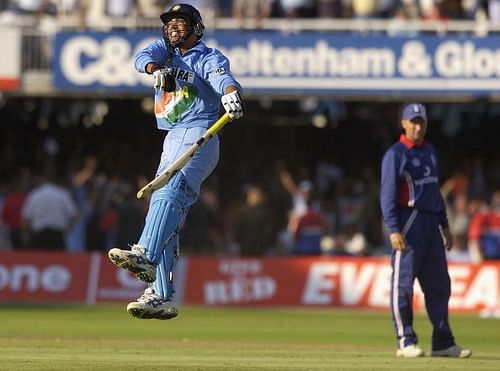
Cricket's Closest Contests: India vs England, Natwest series 2002

Now there is no need for a fake build-up to the suspense. You know what transpired that fateful day at Lords as India and England went toe-to-toe for a chance to lift the Natwest trophy in 2002. India came out as winners (and how!), and Nasser Hussain’s century was rendered as a mere footnote to the extra-ordinary proceedings on display that day. Sourav Ganguly did something legendary, paying homage to the Great God of cricket from the balconies of its Mecca in his own special way, simultaneously exposing the world and the shocked members of the great stadium to his unkempt chest hair and flagrant swearing; a tremendous double effort which in one go shattered the clean, ‘good boy’ image of the Lords. Yuvraj Singh and Mohammed Kaif did not get the memo, and insisted on spoiling England’s party like drunken revelers at a carnival. When the dust had finally settled, India had ended up recording the then biggest ever chase in ODI history and sending Ravi Shastri in to his all-too-familiar delirium mode in the commentary box.
It’s easy to be distracted by the above-mentioned events and leave the match at that. But that would mean disregarding a sensational batting performance by the English that set the tone for a sensational encounter. If India pulled off a miraculous win of epic proportions, then the English deserve a lot of that credit for pushing India to the brink and nearly coming off with a win. On another day, England would have routed the opposition for a huge 100-150 run win, and Nasser Hussain would have been the toast of the town for orchestrating a perfect day of cricket for the home fans. It was almost his day, but it took a sterling performance from the Indian batsmen to overshadow Hussain’s one and only ODI ton.

The English skipper’s century celebration was unsually vocal this time around, choosing to point at his shirt number and raising three fingers in the general direction of the commentary box; a riposte to constant criticisms from the media, notably Ian Botham and Bob Willis, about his decision to bat at number three. 115 runs off 128 balls, coupled with Trescothick’s run-a-ball ton, meant India had to do the early running and play catch up for the rest of the game. The pair put on 185 in 167 balls after Nick Knight’s dismissal in the 8th over, effectively shutting out the opposition. No bowler was spared, apart from Zaheer Khan who managed to come away with 3 wickets for 62, the only maiden over for the bowling team and his reputation intact. Flintoff’s quickfire 40 of 32 balls ensured England crossed the 300 mark easily and by the time Hussain departed in the 48th over with the score at 312/4, the damage was done and the writing was on the wall. India would have to chase down a daunting target of 326 to get the trophy.
The mood in the Indian camp at the innings break could not have been one of supreme confidence, because this was England’s highest score for ten years at Lords. But the mammoth target must have influenced the Indian approach to the chase. They would have to go for broke, or lose trying. There was no time to settle down and think. And that is why it was perhaps a blessing in disguise that Ganguly and Sehwag came out to bat first. One’s a fighter, and the other never really respected any bowler. If anyone could get Indians off to a good start, it was these two. Ganguly doesn’t get enough credit for this but the way he adjusted his body position time and again to score off the cover and point areas was elegant and intelligent cricket at the same time. And when Hussain finally relented and removed all his slip fielders and packed the offside, Ganguly did one even better and carted Flintoff over the cover boundary for six in the 10th over to take the score to 63/0. Sehwag did his bit too, treating a distinguished bowler like Darren Gough with disdain. England rallied back with Alex Tudor and Ashley Giles and by the time the openers departed, India were a healthy 114/2 after 16 overs, cruising well above the asking rate.
England has a history of producing seemingly non-threatening yet annoying medium pacers that derail a perfectly good batting performance. Mark Ealham was one and Ronnie Irani did his bit that day. Dinesh Mongia and Rahul Dravid fell to Irani’s dibbly-dobblies (originally a word coined for Mohinder Amarnath’s criminally slow medium pacers) in quick succession, and the situation for India went from “in a little bit of bother” to “all hands on deck” as Tendulkar departed in the 24th over with the score at 146/5. Ashley Giles was easily England’s best bowler on the day, and made a mess of the wickets to send Sehwag and Tendulkar back. No one in their right mind expected Yuvraj Singh and Mohammed Kaif to bring home the cup from that point on, but it was still heartwarming to see that there was plenty of fight left in the Indian lower-middle order. The duo pulled, cut and ran their fair share of runs in the next few overs and refused to roll over. Hussain’s hand was forced and he had to bring in Giles to get rid of the last recognized batting pair, thus using up his best bowler. To be fair, England did not have a genuine match-winning bowler in their armory and the Indian duo saw through this. A stunning sweep shot from Yuvraj Singh off Giles’ bowling brought up the 200 in the 34th over, and now it was England who were in desperate need of a breakthrough. Irani was put in his place and even Gough had an off day as the wicket remained true throughout the match.
The risk of losing either Singh or Kaif was always there as they were both indulging in low percentage shots to keep up with the asking rate. And it was Paul Collingwood that got England the priceless breakthrough with the wicket of Yuvraj Singh in the 42nd over, leveling the match once again in England’s favour at 267/6. Harbhajan Singh played a cameo, hit a one-handed six off Collingwood and, most importantly, gave company to Mohammed Kaif for five solid overs as India inched closer. Even a double-whammy from Flintoff in the 48th over to send both the Indian spinners, Harbhajan Singh and Anil Kumble, packing seemed to be a case of too little too late. And with Ravi Shastri’s famous words echoing in our ears, we watched as Kaif did his little victory jig with Zaheer Khan after securing a historic win for Team India.

The “exuberance of youth” and “infectious enthusiasm” are usually the adjectives bandied about after a youngster plays a match-winning knock, but in this case, it would be unfair. The openers set the agenda for India, and the lower middle order carried the team home. This was a classic case of dogged determination from the batsmen, refusing to give in, in the face of unrelenting pressure. Or perhaps it was personal. Ganguly certainly would have us believe that, with his amusing yet spontaneous shirt-waving celebration; returning the favour to Flintoff who removed his after securing a 3-3 draw in the reverse ODI series in India a few months ago. Ganguly would later be reprimanded for that incident which “tarnished the image of the gentleman’s game”; a small price to pay for an act that will go down in Indian cricket folklore. One wonders if the same punishment was meted out to the gentleman who threw a can of beer at Micheal Bevan during the presentation ceremony of the 2001 Natwest final.
Spare a thought for the English team though. Only a handful of times has it happened in ODI history that a side batting first had two centurions yet ended up losing. India certainly went against the tide that day.
Here’s a look back at some of the highlights of the Indian chase.